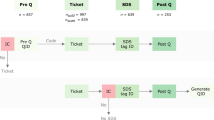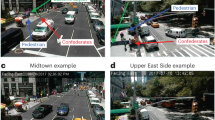Abstract
This study examined the microinteractions of pedestrians in Japan and in the United States as they walked past a confederate. Specifically, the effects of culture, condition (avoid, look-only, and look plus smile) and sex of confederate on glances, smiles, nods, and greetings by passing pedestrians were examined in a field study on over 1000 participants. The hypotheses of (1) lower responsiveness in Japanese pedestrians than in American pedestrians and (2) increased responsiveness as a function of condition were supported in a series of log-linear analyses of pedestrian glances, smiles, nods, and greetings. Both of these main effects were, however, qualified by Culture X Condition interactions on smiles, nods, and greetings, with the large condition effects present in the American pedestrians, but absent in the Japanese pedestrians. The results are discussed in terms of the functions of glances, smiles, nods, and greetings in these brief encounters and how differing cultural norms affect Japanese and American responsiveness. Finally, the limitations of this study and the broader utility of this research paradigm are discussed.

Similar content being viewed by others
Notes
The results of Patterson et al. (2002) study were completed and communicated to Iizuka several years before the Patterson et al. (2002) study was published. Iizuka used the methodology in his own study in Japan. Revisions and a long publication lag with the Patterson et al. (2002) study resulted in the Iizuka study being published first.
The reactions of all of the pedestrians in the look and look and smile conditions were included whether or not they actually turned and glanced at the confederates in the passing zone. Because this undoubtedly included some pedestrians who did not notice the confederates’ look or look and smile, this constitutes a very conservative test of condition effects.
Before the data collection was started in Japan, the second author visited the first author in the U.S. and discussed the details of the manipulations and the response measures so that the procedures would be standardized in the Japanese sample.
It was not possible to compute a reliability coefficient for the greeting measure with the Japanese data because there was no variability in the observers’ judgments, i.e., they reported no greetings, while the confederates reported a single greeting.
In those instances where there was a confederate and observer disagreement, two decision rules were employed in determining a scored reaction. First, if either person made an uncertain judgment and the other person judged that the behavior was present or absent, the present or absent judgment was selected as the final one. For any other disagreement (e.g., the confederate judging that a smile occurred and the observer judging that a smile did not occur), the confederate’s judgment was selected as the final one because the confederate was closer to the participant when making the judgment.
References
Argyle, M., Henderson, M., Bond, M., Iizuka, Y., & Contarello, A. (1986). Cross-cultural variations in relationship rules. International Journal of Psychology, 21, 287–315.
Bargh J. A. (1997). The automaticity of everyday life. In R. S. Wyer, Jr. (Eds.), Advances in social cognition (Vol. 10, pp. 1–61). Mahwah, NJ: Lawrence Erlbaum Associates.
Bargh, J. A., Chen, M., & Burrows, L. (1996). Automaticity of social behavior: Direct effects of trait construct and stereotype activation on action. Journal of Personality and Social Psychology, 71, 230–244.
Cary, M. S. (1978). Does civil inattention exist in pedestrian passing? Journal of Personality and Social Psychology, 36, 1185–1193.
Cohen, J. (1960). A coefficient of agreement for nominal scales. Educational and Psychological Measurement, 20, 37–46.
Coutts, L. M., & Schneider, F. W. (1975). Visual behavior in an unfocused interaction as a function of sex and distance. Journal of Experimental Social Psychology, 11, 64–77.
Doi, T. (1973). The anatomy of dependence. Tokyo: Kodansha International.
Ellsworth, P. C., & Langer, E. J. (1976). Staring and approach: An interpretation of stare as a nonspecific activator. Journal of Personality and Social Psychology, 33, 117–122.
Elman, D., Schulte, D. C., & Bukoff, A. (1977). Effects of facial expression and stare on duration on walking speed: Two field experiments. Environmental Psychology and Nonverbal Behavior, 2, 93–99.
Fleiss, J. L. (1994). Measures of effect size for categorical data. In H. Cooper, & L. V. (Eds.), The handbook of research synthesis (pp. 245–260). New York: Russell Sage Foundation.
Fridlund, A. J. (1994). Human facial expression: An evolutionary view. San Diego: CA: Academic Press.
Goffman, E. (1963). Behavior in public places. New York: Free Press.
Hall, J. A., & Halberstadt, A. G. (1986). Smiling and gazing. In J. S. Hyde, & M. C. Linn (Eds.), The psychology of gender: Advances through meta-analyses (pp. 136–158). Baltimore: Johns Hopkins University Press.
Hinsz, V. B., & Tomhave, J. A. (1991). Smile and (half) the world smiles with you, frown and you frown alone. Personality and Social Psychology Bulletin, 17, 586–592.
Howell, D. C. (2002). Statistical methods for psychology (5th edition). Belmont, CA: Duxbury Press.
Iizuka, Y. (2001). Civil inattention in pedestrian passing. Bulletin of the Shimane Nursing College, 6, 133–138.
Lebra, T. S. (1976). The Japanese pattern of behavior. Honolulu: University of Hawaii Press.
Levine. R. V., Martinez, T. S., Brase, G., & Sorenson, K. (1994). Helping in 36 U.S. cities. Journal of Personality and Social Psychology, 67, 69–82.
Matsumoto, D. (2006). Culture and nonverbal behavior. In V. L. Manusov, & M. L. Patterson (Eds.), The Sage handbook of nonverbal communication (pp. 219–235). Thousand Oaks, CA: Sage.
Milgram, S. (1970). The experience of living in cities. Science, 167, 1461–1468.
Miyashiro, G., Inui, M., & Takeuti, Y. (1984). An empirical study of perceived visual privacy. Proceedings of the Association of Japanese Architecture, 355–356.
Newman, J., & McCauley, C. (1977). Eye contact with strangers in city, suburb, and small town. Environment and Behavior, 9, 547–558.
Patterson, M. L. (1976). An arousal model of interpersonal intimacy. Psychological Review, 83, 235–245.
Patterson, M. L. (1982). A sequential functional model of nonverbal exchange. Psychological Review, 89, 231–249.
Patterson, M. L. (1983). Nonverbal behavior: A functional perspective. New York: Springer-Verlag.
Patterson, M. L., & Tubbs, M. E. (2005). Through a glass darkly: Effects of smiling and visibility on recognition and avoidance in passing encounters. Western Journal of Communication, 69, 219–231.
Patterson, M. L., Webb, A., & Schwartz, W. (2002). Passing encounters: Patterns of recognition and avoidance in pedestrians. Basic and Applied Social Psychology, 24, 57–66.
Triandis, H. C., Bontempo, R., Villareal, M. J., Asai, M., & Lucca, N. (1988). Individualism and collectivism: Cross-cultural perspectives on self-ingroup relationships. Journal of Personality and Social Psychology, 54, 323–338.
Webb, E. J., Campbell, D. T., Schwartz, R. D., & Sechrest, L. (1966). Unobtrusive measures: Nonreactive research in the social sciences. Chicago: Rand McNally.
Zuckerman, M., Miserandino, M., & Bernieri, F. J. (1983). Civil inattention exists – in elevators. Personality and Social Psychology Bulletin, 9, 578–586.
Acknowledgements
We want to thank the students who served as confederates and observers: Kazuaki Maehara, Masaki Miyata, Seiji Nishimura, Akiko Seno, Kayo Sakaguchi, Masumi Imano, Susan Heine, Sara Larez, Greg Van Mierlo, Wesley Ruehl, and Travis Fitzgerald.
Author information
Authors and Affiliations
Corresponding author
Additional information
Parts of this study were presented as a poster at the meeting of Society of Personality and Social Psychology, Palm Springs, CA, January 2006.
Rights and permissions
About this article
Cite this article
Patterson, M.L., Iizuka, Y., Tubbs, M.E. et al. Passing Encounters East and West: Comparing Japanese and American Pedestrian Interactions. J Nonverbal Behav 31, 155–166 (2007). https://doi.org/10.1007/s10919-007-0028-4
Published:
Issue Date:
DOI: https://doi.org/10.1007/s10919-007-0028-4




